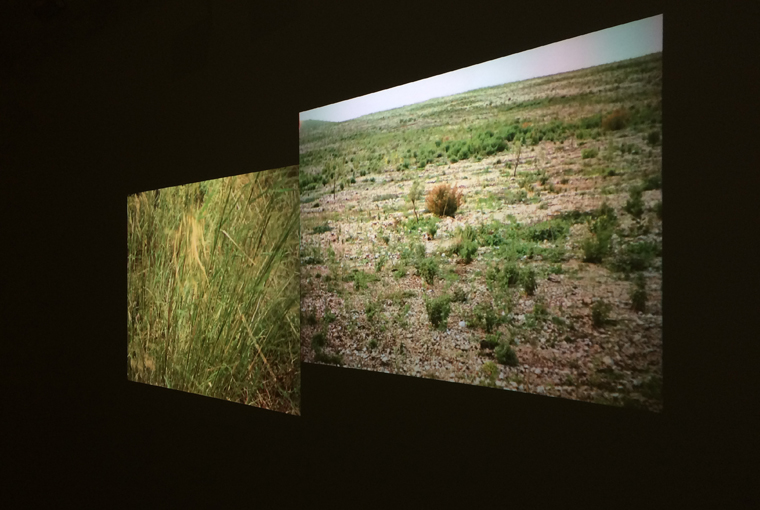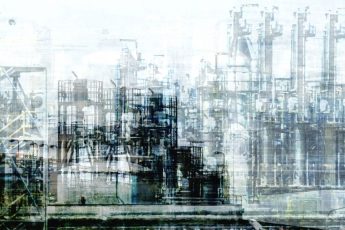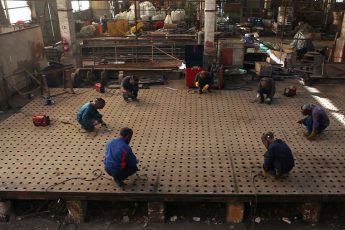Filming Absence
Ana Hušman’s Almost Nothing (2016) & Péter Lichter’s Non-Places: Beyond the Infinite (2016)
Vol. 70 (December 2016) by Rohan Crickmar
Two short experimental films coming out of an Eastern European milieu and focusing primarily on what isn’t seen does not necessarily posit an aesthetic trend, but it is remarkable how both Ana Hušman and Péter Lichter skirt around the visible as a defining element of each of their most recent shorts. Croatian film artist Hušman has a cooler, more measured and stately approach to absence, whereas Hungarian experimental filmmaker Lichter offers up an immediate and visceral apprehension of loss. However, both filmmakers are working with a far wider array of philosophical concerns that are rooted in how we construct, divide and manage space, and, perhaps, how we absent something vital from terrain that we manipulate and transform for our own ends. In Hušman’s film the works of Jean-Luc Nancy are foregrounded, particularly that of his 1993 text Le sens du monde, with its dire warnings about the human colonization and conversion of the ‘natural’ world. Cultivation and organization of the land for the purposes of human society is critiqued in Hušman’s film in line with Nancy’s idea of the world being harmed by its treatment as object by humanity. Lichter, by comparison, is explicitly working through the concept of a ‘non-place’, posited by French anthropologist Marc Augé. Looking at the roadside truckstops and rest areas of Hungary as if they were unknowable aspects of the infinite, comparable to what an astronaut may be expected to encounter in the apparent vast emptiness of deep space, the director seems to suggest these alienating ‘non-spaces’, in their innate process of absenting, force humanity to burrow inwards and try to find meaning within, which has terrifying consequences.
Ana Hušman, born in 1977, is a graduate of Zagreb’s Academy of Fine Arts, who has come to increasingly use film as a primary medium for her aesthetic explorations. Early in her career she developed a stop-animation process under the tutelage of Nicole Hewitt and has frequently used variations of this process in her body of film work. However, Almost Nothing, is a further move away from these early interests in animation, coming after the predominately filmic and photographic concerns of her 2013 work Postcards. Péter Lichter, born in 1984, is a student of film history and theory, who wrote his doctoral thesis at ELTE University in Budapest. He has been working within experimental film circles since 2002, although his earliest passions in film seem to belong to genre fare, particularly horror. Much of his work, up to Non-Places: Beyond the Infinite, utilized found footage and hand processing techniques.
The wind almost literally carries Hušman’s film. Shot entirely upon the Croatian island of Korčula, the film is split into roughly three sections. The first of these examines the interior of a non-descript, and uninhabited, holiday apartment, through which the wind occasionally gusts. The apartment is presented in a series of fixed frame shots, with much of the interior décor of the apartment subtly reflecting aspects of how wind operates within the natural world (a picture of a boat riding a choppy sea, or a child’s mobile). While the measured editing of Iva Kraljević seems to suggest a calm, lifeless tranquillity, Tomislav Domes’ omnipresent sound design, interlaced with narration of the wind’s effects upon the various flora of the island (or more technical detailing of the gradations of wind as measured by the Beaufort scale), introduces the idea of an invisible force of nature that will not be controlled, tamed and quantified. The narration is curiously delivered in a clipped and annoyingly precise English, that gives an explicit accent to the colonizing ideology that informs Nancy’s thinking on the human relationship to nature.
After such an arresting opening section, the film then moves out into the wild hills, moors and rocky outcrops of the island. Hušman chooses to label these images with information about the sound recording, i.e. what type of wind is blowing on, or through, which plant. Occasionally she gives further information about the precise location. The sudden interconnection between aural and visual information makes for a truly impressive middle passage. The film comes to rest at a small coastal property, by a jetty, where the director finally places herself into the film as an agent of consciousness, with the sentence appearing on the screen, “I sit here looking”. Thus, the film has moved from the human space of division and organization, that nature can only slightly disrupt, to the natural space of contingency and risk, in which the human need to apprehend is played out through language. Only in the final sequence can the full extent of Hušman’s thesis be felt, with the landscape assembled through the sound of how the wind interacts with manmade processes of cultivation and intervention. Both the natural process of the wind and the presence of humanity are absented from the visual plane of the film, only their effects can be observed, the human terraforming of the land, and the wind’s acting upon flora and drapery.
If the absence of Hušman’s film is the absence of immediately visible agency, thus allowing for the capacity to willfully ignore significant processes of transformation, then Lichter’s film is haunted by the absence of meaning, and the full horror of realization. It is worth heeding what Lichter has said about his filmmaking in an interview with Hungarian film critic Dorottya Szalay, “my work is not just an analysis of the experience, but the creation of a new experience at the same time”.1 In promoting this film on the festival circle, Lichter has also referred to it as being a work looking at Marc Augé’s idea of the ‘non-place’, through the prism of Kubrick’s 2001: A Space Odyssey (1968). I would suggest that the film is also, consciously or unconsciously, informed by Emil Cioran’s bleak philosophy of decay.
Working on digital video, Lichter has manipulated b&w footage of various truckstops and rest areas along Hungary’s roadsides. The director’s roadside footage is forced through a violent and discombobulating array of revolutions, approximating the free floating, multi-directional movement of a space capsule adrift in space. This disorienting effect is further enhanced by the digital ageing effects that Lichter uses to replicate the wear and tear of celluloid film. To further complicate matters the director splices in to the constant revolutions of the camera, moments of stasis that seem to be little windows of 8mm found footage film depicting the growth of an infant into adulthood.
Gravity and time now become primary themes in the work. The way in which these home movie memories dissolve back into the spatial dislocation of the roadside non-place, suggests a vertiginous acceleration of decomposition. As the film moves inexorably toward its conclusion, the soundscape becomes ever more harrowing, and the memory movies come to predominate over the swirling footage of the non-place. What had been absent from all the non-place footage was any meaningful human presence. Lichter’s decision to film this in such an immediate and physically alienating manner, has effectively made those moments of clearly discernible humanity like life-rafts to cling on to for dear life in a stormy and chaotic sea. Where Cioran’s mark can be discerned is in the way that Lichter then cruelly transitions from this sense of safety in the memory movie’s reassuring images of humanity, to a horrific realization of the full import of those images – namely, the decomposition of the human being over time.
Stuck within the chaotic nebulousness of the revolving non-place, Lichter’s camera forces the viewer to strongly identify with the sops of humanity thrown up out of the maelstrom. When those sops cohere into a life only for that life to be led to the very point of dissolution and decay, it expertly fulfils Lichter’s notion of his films as analyzing experience whilst simultaneously forming new (or, perhaps, renewed) experience. It should come as no surprise that Lichter frequently mentions, among his Hungarian contemporaries, the filmmaker Bence Fliegauf, whose Lily Lane (2016) had a similar approach to locating horror within a realization that decay forms the very essence of being. Chillingly, Lichter seems to suggest in this powerful and compact work, that the true visual absence of his film is not the non-place without, but the non-place within.




Leave a Comment